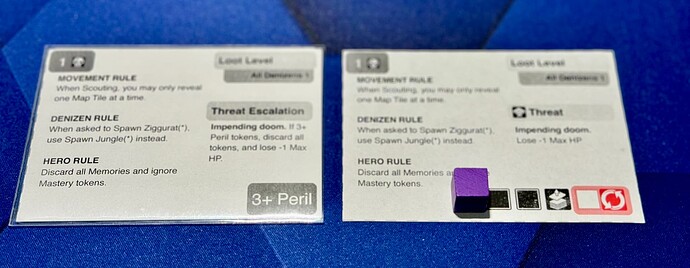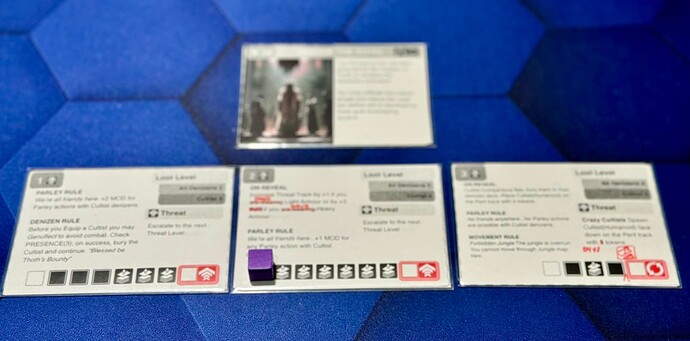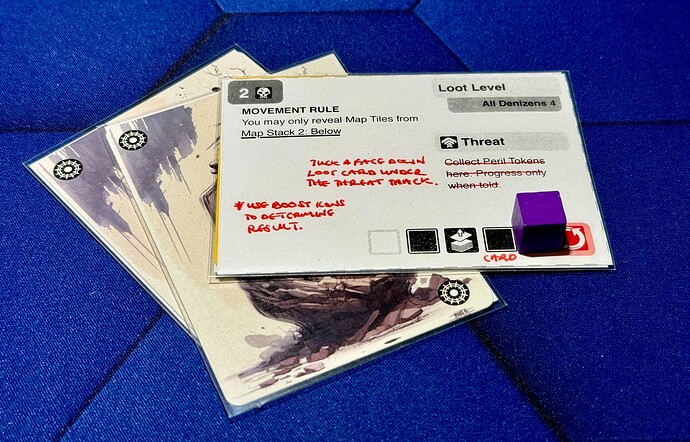One aspect of gameplay that proves somewhat unpredictable is the Peril encounters, drawn from the Peril deck at the conclusion of each game turn. At times, these encounters delightfully align with the game’s theme, creating a coherent turn of events for the quest. However, on other occasions, they can disrupt the narrative’s flow.
The pacing of these quest-specific encounters significantly influences the overall “smoothness” of the game loop. Ideally, the quest should introduce something unexpected and intriguing every few turns. My initial strategy involved balancing the ratio of significant versus insignificant peril cards to establish a natural rhythm. This method often works well, but occasionally, a series of overly “interesting” encounters can occur, causing the main storyline to be overshadowed.
While working on the Tutorial quests it became particularly annoying as I’m trying to orchestrate the introduction of game rules from simple to more complex and a random Peril card just tosses in an “interesting” scenario for a beginner to struggle through at the end of the first game turn.
Overrun and Imperilled
Ever felt like you just can’t catch a break? That’s how it was when the Hero got chased down by monsters (Overrun), only to run smack into another hostile crew (unlucky Peril Card) in the next step of the Peril phase.
An improvement that worked really well for a while was merging the Overrun and Peril Card steps into a single either/or condition, the “Peril Encounter” step of the Peril Phase. But this only took care of this rare, albeit very frustrating, scenario; something more was needed.
Taming the Peril Cards
Jumping into the Tutorial quests, I bumped into a bit of a snag with the Peril cards. The idea was simple: start players off easy. Instead, a Peril card would pop up in the first round and start throwing curveballs too soon for beginners.
So, I decided to give the Peril cards the boot in the first tutorial. And just like that things got a lot smoother. Riding that wave, I axed them from a full quest (Thoth’s Bounty). To my surprise, it held up pretty well. However, the issue wasn’t the cards themselves but their habit of popping up too often and at the wrong times.
Here’s the thing: at the start of a quest, players want to keep the party moving without unnecessary stops – no healing, no rest actions, no “time passes”. And when you’re heading towards the big finale? You want the main story to take centre stage, not get sidetracked by random Peril card antics.
Time to recalibrate when and how these Peril cards make their entrance.
Back On the Track
Rewind to the early days of Ziggurat, and you’d find a pretty rigid “threat track” at its core. Players would do stuff, climb up this track, and once they hit the top, boom – the overall “threat level” cranks up and we start all over. Neat idea, but each quest had its own vibe about how fast things should heat up, so a one-size-fits-all track? Not the best fit.
This was replaced with a token pool akin to the sort of marker you find on popular LCG card games like LotR and Arkham. Tokens accumulate on the current threat card and once they hit a specific threshold the deck progresses to the next Threat level.
Recently, I’ve been working on a mash-up of the token pool, custom escalation and the original fixed threat track; a sort of unholy, bespoke, Franken-track printed on each Threat level card that lets you set a different tempo for each threat level of each scenario.
For this to work the Peril Phase changes to:
- Process Peril track as needed
- Overrun; if pursuers catch up
- Threat increases (combines peril encounter and threat escalation into one)
- Party clean-up
The track moves forward every “Time Passes” event during play. During this new “Threat increases” step you move the track forward and then action any icon that the threat marker moves onto; for example, do nothing or draw a peril card. If the marker reaches the end of the track you activate the bespoke escalation action and then either reset or turn over to the next threat level.
Moth to a Flame: Tutorial 1; old and new hotness
Thoth’s Bounty; series of Threat Levels 1-3 with new hotness
Reliquary of Q’Arn; tucking Loot cards for Boost points
The track uses simple iconography that i think makes sense. Just not sure how well putting a tracking cube on the Threat Level card is going to work .
The mechanism gives good control over the tempo of the peril card output in different phases of a quest. For those scenarios that use a value derived from collected tokens, the track resets frequently and the Hero places a face down Boost card to determine the value upon escalation – which is an interesting improvement, hiding in a suspenseful way how high that value might be.
Having peril tokens as dedicated tracking cool downs on cards you remove and not threat level tokens you add somehow “makes better sense”. Pushing the track cube during the Peril Phase every game turn “feels more fun”; more obvious, more suspenseful.
Can you ignore the “vibe” of a change even when you can’t quantify the benefit?
Rod For Your Own Track
So not quite officially a change just yet. Need to be really sure about this one.
Going forward triggers a cascade of content changes and re-balancing:
- remastering all Threat cards
- remove and rebalance Peril decks for each quest
- play test and re-balance all quests
So hey ho the merry oh, a playtesting we will go.


